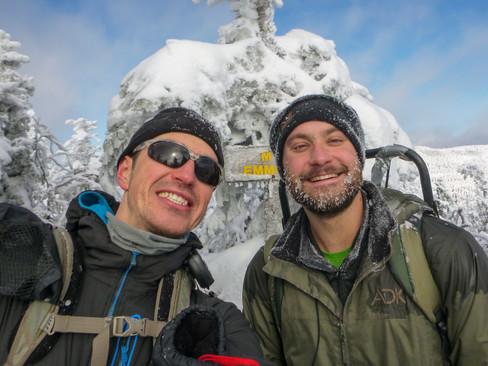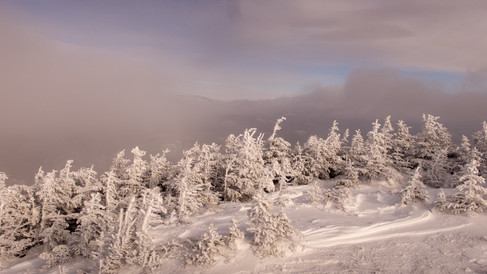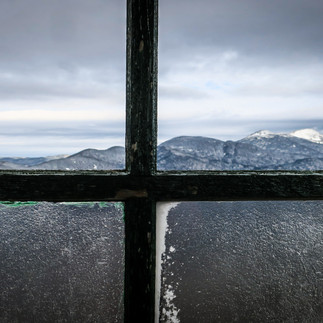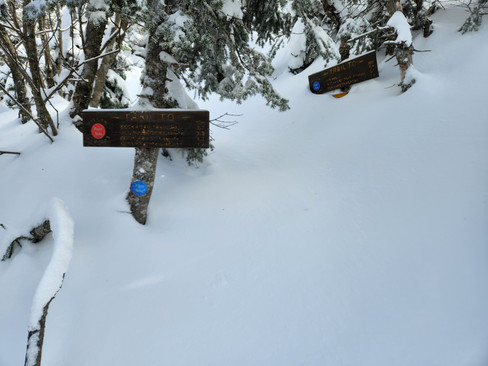My Winter 46
- Andrew Meunier
- Mar 10, 2023
- 20 min read
Updated: Mar 15, 2023

Many upstate New Yorkers are familiar with the Adirondack 46ers but may not know that there is a winter version of this peak-bagging challenge. To become a winter 46er, hikers must summit all 46 Adirondack high peaks during the winter season– December 21 through March 21. I started this challenge in 2014 and winter quickly became one of my favorite times to hike. The challenge has been a humbling one and it took me almost a decade to complete (I wrote a post here about winter hiking more generally and the lessons I've learned while partaking in this demanding but rewarding pastime).
A few statistics about my winter 46 journey:
Total trips: 31
Coldest start: -18 degrees Fahrenheit (Street and Nye)
Longest hike: about 21 miles (the Seward Range)
Shortest hike: about 8 miles (Wright Peak)
Earliest wake up: about 3:30 AM (the Seward Range)
Strongest winds: about 70 mph (Haystack attempt)
Solo hikes: 1 (Wright Peak)
Group hikes (with successful summits): 6
Most mountains climbed in one day: 4 (on four different occasions)
Total mountains I planned to hike on a given day but failed to summit: 14
Below is an annotated list of the hikes I did together with some pictures, videos, and notes.
Dial: 12/28/2014

I was home visiting my family for Christmas when my friend Chris invited me to join him on this winter hike. I had limited experience with snowshoeing and winter hiking generally. The weather was cold but there wasn’t much snow; we used microspikes for most of the hike (a new piece of gear for me). The plan had been to climb on to Nippletop Mountain, but the layers of socks I had worn with my summer hiking boots proved insufficient for the low temperatures. I also wore light leggings as I would for a cold weather run. The wind was cutting through these easily, freezing my nether regions. Chris agreed that we should head back and visit Nippletop another day.
Although I wasn’t especially comfortable, I remember enjoying the solitude and the beauty of the winter landscape. I also was intrigued by the challenge and was excited to try again with better equipment and planning.
Lessons: I learned that I had a lot to learn. I bought a pair of insulated boots soon after this hike and started thinking about how I could better protect myself from the wind.
Whiteface and Esther: 3/5/2017
It was a few years before I had another opportunity to hike in the Adirondacks because I had been living hours away in Rhode Island. But a recent move back to the area sparked renewed interest in Adirondack hiking. This was a snowier hike than my previous winter outing and I reveled in the magical ice formations that adorned the summit of Whiteface. It was my first time up Esther, where stunted trees sparkled with new fallen snow and ice crystals. I can tell from the few pictures we took that I was hooked on hiking in the winter.
Lessons: This is my first trip with my giant down jacket. This is still my go-to garment for hiking near or above tree line or for any prolonged break.
Colvin and Blake: 3/11/2017
Just a few weeks after our Whiteface hike, Chris and I decided to climb these two peaks from the AMR property. There was significantly more snow than had been present the last time I had been in the area (hiking Dial). This was my first experience working hard to hike through heavy snow. There was plenty of tumbling and sliding into powdery drifts. Chris’ frozen facial hair says it all; by the end of the day, we were one with the snow.
Big Slide: 1/14/2018
Chris, Dylan, and I climbed Big Slide via the Brothers, enjoying lovely views of the Great Range as we climbed. It was bitterly cold and I got thoroughly chilled on the ridge approaching the summit. A lighter jacket I was trying as an active outer layer turned out to be a dud– not enough insulation and no hood. I learned how important it is to stop and make layering adjustments before cold sets in (it’s much easier to stay warm than it is to get warm).
Phelps Mountain: 2/21/2018
Rashna and I were enjoying a “staycation” in and around Lake Placid and decided to get a hike in. There had been a tremendous thaw and there was little need for snowshoes as we hiked past Marcy Dam on the way to the start of the Phelps herd path. The path, steep and heavily eroded under the best of circumstances, was basically a small stream flowing over ice. Our microspikes did fine on the way up and we enjoyed the warmest winter summit temperatures I have ever experienced. But the descent was harrowing and it was a constant struggle avoiding a dangerous slip on the steep, icy trail. I had been hoping to introduce Rashna to the joys of winter hiking– this hike set back that project for at least a few years, if not indefinitely.

Lessons: This hike taught me the limitations of microspikes. This trip called for full crampons, at least for the descent.
Algonquin and Iroquois: 1/12/2019
This was the first winter hike that I did with my local Adirondack Mountain Club chapter. It was a bitterly cold day and two members of our group turned back (one for cold feet and one concerned about frostbite on his face). I had to adapt to the different dynamics of a group winter hike. With so many people needing to adjust gear, change layers, etc., the going could be slow at times. I learned to have a layer on hand to pull on any time we paused. Algonquin was characteristically windy, but I pulled on every layer I had (including snow pants, which I was still toting in my winter bag at that time) and was cozy enough. We had lunch in a sheltered spot between Algonquin and Iroquois. I stumbled into a spruce trap and decided to just eat my lunch half buried in snow as I was quite comfortable! We decided not to push our luck as temperatures continued to drop and skipped climbing Wright Peak on the way home.
Lessons: This cold and windy day was the last time I tried to wear leg tights when hiking (even though I was wearing multiple layers of insulated tights). Looser pants have better wind stopping and insulating properties. This was the first hike I wore goggles for a long stretch of time to protect my face above tree line.
Sawteeth, Gothics, Armstrong, and Upper Wolfjaw: 1/19/2019
This was the first hike I did with Jared since he returned from a conquest of the Colorado fourteen thousand footers. Our pace up the Weld trail towards Sawteeth was blistering and I was sweating at an alarming rate. Luckily, I had came prepared with fresh base layers to change into. I lost a water bottle while sliding down Sawteeth in very snowy conditions. We climbed Gothics, Armstrong, and Upper Wolfjaw in quick succession with only some short stops for snacking and wayfinding. The wind had erased any evidence of a trail and there was plenty of powdery snow. A large snow storm was moving into the area and we could see its leading edge from the ridge. The damp snow started falling as we descended to the Lake Road and we were on the highway just as the heavy weather began in earnest.
Lessons: I learned to keep anything important clipped securely to my bag. My hands got quite cold during the final miles of this hike because the falling snow meant my liner gloves got damp anytime I need to remove them from my mittens. My hat was also wet. I now bring extra pairs of liner gloves on every hike as well as at least one extra hat.
Nippletop (and Colvin, Blake, and Dial): 2/20/2019
Jared and I returned to the AMR property about a month after our previous hike to try a large loop that would finish off the peaks in that area for both of us. Jared was recovering from a nasty head cold and his snot rockets featured an almost neon green discharge. We made great time, however, and the Nippletop summit was a highlight. One of my snowshoes broke on the descent from Dial but I was able to repair it with some zip ties. This hike as around 20 miles and was my longest day to date.
Lessons: This was the first hint that the model of snowshoe I was using may not have been up to the rigors of Adirondack hiking.
Colden: 3/17/2019
This was an Adirondack Mountain Club chapter hike with a large group, including one hiker finishing his winter 46. In his honor, we were asked to all wear bowties and several also wore Hawaiian shirts. The weather on this hike was wild, ranging from low temperatures in the morning to blustery snow on the summit with more spring-like conditions on the hike back. We struggled to stay on the trail after Lake Arnold and spent significant time wandering through knee deep snow wending our way towards the summit. We didn’t linger on the top long due to ferocious winds. On the hike back to the Loj, songbirds snacked from our hands near Marcy Dam.
Lessons: Like my MacIntyre Range hike earlier in the season, this winter hike with a large group required me to be smart about using group breaks efficiently (which can be rather frequent as people need to adjust layers, get snacks, etc.). When stopping more than I normally would , it’s especially important to have an insulating layer close at hand to throw on anytime the group pauses. This was my first hike wearing my Outdoor Research Ascendant Hoodie jacket which is now a staple in my layering system. This jacket is light and breathable enough to be worn while hiking in cold conditions and the hood is great way to further regulate my temperature.
Giant: 1/25/2020
This was an Adirondack Mountain Club outing that I led with my friend Ben. The plan had been to summit Rocky Peak Ridge as well but a precipitous ice cliff on the way to that peak (and incoming rain) led us to turn around. This was my first use of full crampons, which I donned before the descent. These proved to be invaluable on the long, icy sections of trail that would have been terrifying without the extra traction.

Lessons: I learned how useful full crampons can be, especially on icy descents. I now bring these with me on most winter hikes.
Cascade and Porter: 2/2/2020
I hiked these with my friend Anthony. The summit of Cascade was mostly socked-in with strong wind and Porter wasn’t much different. It was fun tramping through deep snow between the two peaks.
Donaldson, Emmons, Seward, Seymour: 2/17/2020
This hike was one of the more epic trips I’ve undertaken in the Adirondacks. Jared, Anthony, and I met in Glens Falls around 4:30 AM and were on the trail around daybreak. Conditions were excellent, although we had to do some trail-breaking on the way up Caulkins Brook. Anthony became a 46er on Seward. Jared and I snagged Seymour, enjoying some of the most breathtaking butt-sliding I’ve experienced (my ears actually popped several times on the descent). We raced back to the car and arrived just as the sun was setting.
Lessons: The hard-driving nature of this trip meant I spent most of the hike wearing just two summer-weight long-sleeved Patagonia shirts, one with a quarter zip. This has become my standard combination when my exertion level is high (unless it is extremely cold, in which case my forearms tend to get cold in this configuration).
Tabletop: 2/29/2020
I co-led this Adirondack Mountain Club outing. We had great conditions and a nice, small group. I did a fair amount of trail breaking on the final stretch up Tabletop which was surprisingly fun. This was one of the mellower winter high peak hikes I’ve had with lots of time to just enjoy being outside in the winter landscape.
Lower Wolfjaw: 3/14/2020
I orphaned this peak on the end of the Great Range when Jared and I climbed its neighbors in January 2019. I figured it would be a chance to lead another winter outing, again with Jeff. Winter was definitely waning and conditions were on the warm side with damp snow, especially as the temperatures rose throughout the day. The final stretch near the summit included a substantial slab of steep rock covered in hard ice. Those of us who had crampons used them, but snowshoes and microspikes were (barely) sufficient for everyone else. The summit was bathed in sunshine and we enjoyed a lengthy respite before tackling the ice cliff again– a much more formidable obstacle on the way down. We ended up using paracord to shuttle our three pairs of full crampons between the top and bottom of the ice face so that everyone could use a pair on the way down. This took the better part of an hour, but conditions were pleasant, and some people got to use crampons for the first time. We all arrived back at our cars safely.
The world we returned to was a changed one. My school shut down the following week due to the COVID pandemic and this hike was my last group outing for some time.

Wright Peak: 12/29/2020
When I climbed the rest of the MacIntyre Range with an group in January 2019, we opted to skip Wright due to the bitter cold. Although I am wary of winter hiking in the High Peaks alone, I enjoy the occasional solitude of hiking by myself. I was gaining confidence in my abilities and decided that Wright was a reasonable first one to try solo since it uses a well-traveled trail and is very accessible. Conditions were cold but with minimal snow cover. I encountered a group of less-experienced winter hikers at the Wright junction trying to access the water in their frozen Nalgene bottle by stabbing it with a large knife. I turned my back on this harrowing scene and ascended to the summit, where I was blasted by the high winds that this peak is known for.
Lessons: I was grateful for my face-covering balaclava and goggles, without which I would have been unable to continue. These can be essential pieces of gear for hikes with any exposure.
Santanoni, Couchsachraga, and Panther: 1/9/2021

An attempted hike of Santanoni Range with Jared’s parents our friend Nate back in my college years (January 2008) was my first real foray into winter hiking. I remember getting hopelessly sweaty and luckily having a dry shirt to change into. The snow levels that day were formidable; we lost the trail and eventually decided we had no choice but to turn back.
My second attempt at this range in winter was with Jared and Anthony. We took the “Santa Express” up Santanoni and experienced high winds on the summit and the range trail. The clouds were unique and the few pictures I took from the Santanoni lookout are among my favorite winter shots (my fingers complained bitterly and took some time to thaw afterwards). It was a busy day with many hikers and we made excellent time on well-broken trails.

Although it was one of my longer winter hikes, this day didn’t feel especially difficult. The trails on this range are rugged and benefited from being “smoothed out” by layers of snow. Best of all, the notorious mud pit on the way to Couchsachraga was thoroughly frozen.
Lessons: I got a chance to use my small repair kit on this hike as Anthony’s microspikes broke a few miles into the hike. In this case, zip ties did the trick.
Rocky Peak Ridge: 1/18/2021
I needed to return to Rocky Peak Ridge after orphaning it in January 2020. Anthony and I came prepared for the ice cliff that had stymied me last time– I had a bunch of webbing in my pack and wasn’t leading a large group that I felt responsible for. The hike up Giant was spectacular with many jaw-dropping views of a wintery Keene Valley. We had no issues getting over to Rocky Peak Ridge as the ice cliff was covered in deep snow and was easy to traverse in snowshoes.

The RPR summit was strangely socked-in and we encountered an enormous hare track between the peaks. This was one of those beautiful winter days where we had time to linger on the way home, enjoying the views and the sunshine.
Marcy, Skylight, Gray: 1/23/2021
This was yet another example of revisiting peaks that I had failed to climb before. Chris and I had tried to summit Skylight and Gray in December of 2016 but had only made it to Lake Tear of the Clouds (monumental snow levels and a totally buried trail had made it impossible for us to continue).

This time, Jared and I decided to climb Marcy first and summited that peak relatively early. There was a wind advisory that day and we sheltered behind one of the summit rocks to regroup before descending to Four Corners. The winds were significantly calmer on the way up Skylight, but we were taking turns breaking trail through several feet of snow which was sweaty and exhausting work. There was more trail-breaking on the way up Gray where Jared finished his winter 46. The march back to the car was very long and I remember being depleted from all the trail breaking. But I was excited about our accomplishment, made all the sweeter since these peaks had eluded me once before.
Saddleback: 1/30/2021
Anthony and I made plans to meet Ben and his companion Claire at the Garden trailhead. The temperatures dipped well into the negative teens on the drive to Keene Valley, but it was a still and clear morning when we set out. Ben and Claire had planned on staying at the Johns Brook Loj overnight and so they had more gear than usual. A chat with the caretaker as we paused on our way to Saddleback led them to question this plan, as the extremely low temperatures made even the shelter of the Loj uncomfortable. Ben and Claire eventually decided to turn back as Claire was having trouble staying warm, even on the move. Anthony and I opted to continue up the Ore Bed trail. The Saddleback ridge offered a gorgeous view of Gothics framed by intricately frozen trees. I love the photo I took here; the winter sun reflecting off the ice clinging to the foliage resembles spring flower blossoms.

We had to do some wayfinding near the summit, but eventually found the top at the end of a persistent set of bunny tracks. The cold was extreme, but the lack of wind and the abundant sunshine meant we were able to linger for some time enjoying views of Basin and peeking over the steep Saddleback cliffs. We caught up with Ben and Claire on the way back and walked back to the car together.
Macomb, Carson, Grace, and Hough: 2/13/2021
Jared and I set out with plans to hike the entire Dix Range. The Macomb slide was our first challenge and Jared deployed his ice ax on the steep terrain. I made do with my snowshoes and their heel lifts. The going was easy once we attained the ridge where we found narrow tracks through the snow. It was only my second visit to these peaks and I especially enjoyed Grace, where we spent about 30 minutes snacking and enjoying the summit (an unusually long break for Jared and I). On the way to Hough, one of my snowshoes failed. The binding had detached from the frame and no amount of zip ties or wire was sufficient to repair it. I ended up using one snowshoe and one microspike to continue to the summit of Hough. The Beckhorn and the Dix summit were in view and they were daunting given my shaky gear situation. We decided to leave Dix for another day and descended back into Hunter’s Pass. I mostly adapted to my strange footwear situation but still had a few awkward stumbles.
Lessons: This was the last straw for these MSR snowshoes that were not really designed for the type of winter hiking I was doing. I was in the market for a new pair but supply chain issues due to the pandemic meant that the models I was looking for were unavailable.
Marshall: 3/20/2021
Jared and I decided to squeeze this hike in on the last weekend of the winter hiking season. It was a sunny and relatively warm day. This was my first-time hiking across the Flowed Lands in winter and it was strikingly beautiful. My older, backup pair of snowshoes stayed mostly on my pack and we made fast time with only microspikes.

Lessons: Ever since I gave up on tights as a lower layer, I had struggled to find pants that were warm, windproof, and not too hot. This was my first hike using the Outdoor Research Trailbreaker II pants which are designed for ski touring. My favorite feature of these pants is the giant zip vents– exceptional for dumping heat when climbing. I now pair these with three-quarter length light tights for every winter hike.
Cliff and Redfield: 1/8/2022
I had been anticipating this hike for years and knew the lengthy approach could be a challenge. But Jared and I had great conditions and made extremely good time on the Calamity Brook trail. We tackled Cliff first and donned full crampons before the first major steep section. I had a few uncomfortable moments on the exposed faces that were slick with hard ice. Jared’s ice axe helped me navigate one tricky section. Going down was less scary and we were soon on our way to Redfield.

We enjoyed some excellent butt sliding during our descent from that peak. This was a hike that ended up being easier than expected, mostly due to good snowshoeing conditions that made the approach feel easier than it might have in summer.
Lessons: This was my first hike with a new winter pack made by Gregory. This 45 liter pack is much smaller than the 75 liter backpacking bag I used previously. It was designed for backcountry skiing and ski touring so has some useful features such as a better attachment system for snowshoes. The entire main compartment is also accessible from the back panel, making it easier to access gear quickly.
Street and Nye: 1/16/2022
I first planned to do this hike as an ADK outing with co-leader Jeff on 1/11/2020. We decided to cancel it due to rain. However, a few of us decided to investigate the area on 1/12/2020 and were treated to a truly terrifying view of Indian Pass Brook which was a raging torrent. Since it was certainly uncrossable, we had to be satisfied with a short hike into Indian Pass (until we hit yet another swollen brook).

Our 2022 hike may have been my coldest start ever, with my car thermometer reading -18°F. The forest was beautiful and seemed to creak and crunch in the way it only does when temperatures are that cold. Jared, Anthony, and I made excellent time on good snow conditions and were thoroughly warmed up by the time we started climbing. This may have been my earliest finish of any winter hike as we were back at the car by early afternoon.
Lessons: This is my first hike using a 64 ounce insulated Hydro Flask bottle as my primary water reservoir (instead of separately insulated Nalgene-style bottles). This bottle keeps my water warm without any additional insulation. I also carry a collapsible (non-insulated) liter container of water that I usually consume within the first hour or so of a hike.
Haystack and Basin: 1/15/2023
Jared and I first attempted these peaks on 1/29/2022 but encountered such strong winds on the summit that we were forced to turn back about 100 yards from the summit. The Whiteface Weather Observatory recorded gusts in excess of 70 miles per hour that day, which explained why we couldn’t safely stand up. Both Jared and I got some minor frost nip. A winter mountaineering school group we met also decided to turn back near the summit.

For my second attempt, we picked a day with moderate winds and temperatures predicted to be in the 20s. Jared and I made good time, hiking in from the Garden trailhead. We had to search for a safe crossing of a swollen Johns Brook, but eventually found our way across. We learned from our previous year’s attempt and were fully geared up (and with my belly full of snacks) before embarking on the ridge between Marcy and Haystack. Winds were strong on Haystack, especially near the summit where they were probably gusting at 45 or 50 miles per hour. But we tagged the summit and sheltered in the lee side of the summit dome where we had brief views of Marcy and Panther Gorge through the clouds. After a pleasant lunch stop back in the shelter of the trees, we climbed Basin and were back to the Shorey Short Cut trail around 3:00. We only needed our headlamps for the final hour of the hike back to the cars.

Lessons: Our 2022 attempt at this hike taught me the importance of anticipating high winds and adding layers before experiencing any exposed sections. Taking in calories before a stretch of exposed terrain is also essential to staying warm. Fiddling with clothes and taking in food is painfully cold in even a slight winter wind.
Allen: 2/11/2023
I first attempted Allen on 2/20/22 with Jared. We thought that a few frigid nights would be enough to freeze the Opalescent River which we needed to cross on the trail to Allen (the bridge that used to span the river was washed out in 2020). Unfortunately, the water was running fast and deep with no obvious crossing points. We decided the prudent thing was to wait for a better day. We hiked up Mount Adams instead, which was actually an excellent alternative. But it was disappointing to have to add Allen to my list of “redo” mountains.

For my second attempt, I was more thoughtful about picking a day for this hike. There is a USGS water gauge for the Hudson River in Newcomb and I used that data to look at previous dates when I knew that hikers had been able to cross the Opalescent safely. It seemed that 2.5 feet was the maximum height of the Hudson for which the nearby Opalescent would be crossable. A look back at our 2022 attempt revealed a depth of well over 4 feet, which explained the intimidating current. Historical temperatures revealed that even a series of cold nights wouldn’t be enough to overcome a high volume of water from a recent melt or precipitation event.
As ever, I was constrained by my work schedule and periods of warm weather and rain that often seemed to climax near my weekend hiking window. The day we chose was forecast to be cool and sunny. The Hudson was swelling from a recent melt and rain event but was still below 2.5 feet. We decided to take our chances and brought heavy trash bags in case we had to ford the river. In the end, we were able to cross without these extreme measures by utilizing a giant block of dislodged ice and an artfully placed log. We made excellent time on the relative flat approach trail and sweated our way up the final steep sections. The sun was abundant and there was almost no wind. The Allen summit was crowded by winter standards, with several groups reaching the top around the same time we did. The start of our trip down was an extended butt slide that dropped us over 500 feet in elevation in just a few exuberant minutes. We ended up making it back to the car around 4:30, well before sunset. The glorious conditions together with the redemptive nature of this hike left me with warm feelings about the experience for days.
Dix: 3/5/2023
My friend Jen and I had planned this hike as an Adirondack Mountain Club outing months in advance, but as the date grew closer, we watched as a forecasted snowstorm threatened to change conditions drastically. In the end, the storm caused us to delay our hike by a day and we knew that a long day of breaking trail lay ahead. Luckily, we were a group of five and were able to divide the work of stomping through the snow without any one of us growing too tired. We quickly fell into a routine of ten-minute turns at the front and we made slow but steady progress, occasionally having to stop to find the trail.
After four hours of hiking, we snacked at the Boquet River lean-to in preparation for the walk to the base of Dix and the start of the real climbing. At around 3,000 feet of elevation, the amount of snow increased significantly, and our progress slowed to a crawl as we broke through several feet of fresh snow on a relentless incline. It took us almost two hours to hike from the base of the first slide to the junction with the Hunters Pass trail. The signs at the junction were almost completely buried in snow.

Having attained the ridge, we were treated to some blue skies and sun, although the wind was blowing strongly. The summit was stark and windswept with bits of snow and ice flying through the air and into the open space beyond the mountain's steep ridge. The Beckhorn and the rest of the Dix Range was just visible through the blowing snow.

After summiting, we found our tracks had been erased by the wind. I took a slightly bad angle off the summit dome and ended up leading the group into a wall of spruce. The wind, then developing into gale, blasted us on the exposed ridge as we stumbled through spruce traps. I confirmed that everyone was warm enough and checked my GPS, determining that we were probably a few hundred yards from the trail. After a few minutes of anxious bushwacking, we located our tracks on the lower slopes and descended to the junction.
With the trail already broken, we made much better time on the way back and our final few hours were spent hiking under a beautiful waxing gibbous. We arrived back at the car around 9 PM after about fourteen hours on the trail. This was challenging day, maybe one of the most physically grueling winter hikes yet. But we had a great group and our teamwork and positive attitude prevailed.

My friend Karen (herself a winter 46er) presented me with a winter 46 "rocker" patch on our way down from Dix. It was fun finishing my last winter peak with a group. I hike alone much more often in the warmer months but, for the sake of safety, I am almost never solo in the winter. Through winter hiking, I've met some great people, had some excellent shared adventures, and was able to learn from companions with more experience. I'm looking forward to returning to the mountains each season with others who revel in the harsh beauty of the Adirondacks in winter– and exploring some parts of the park that aren't on any list.




















































































































































I notice my presence in all accounts that mention the word 'sweat', I have done my work. Don't know if I heard the account of people knifing for water in frozen bottles, thats a good one.
This was so impressive, for the accomplishment and the thoroughly engaging narrative as well. Congratulations!
Congratulations on finishing!
Auntie HeeHee